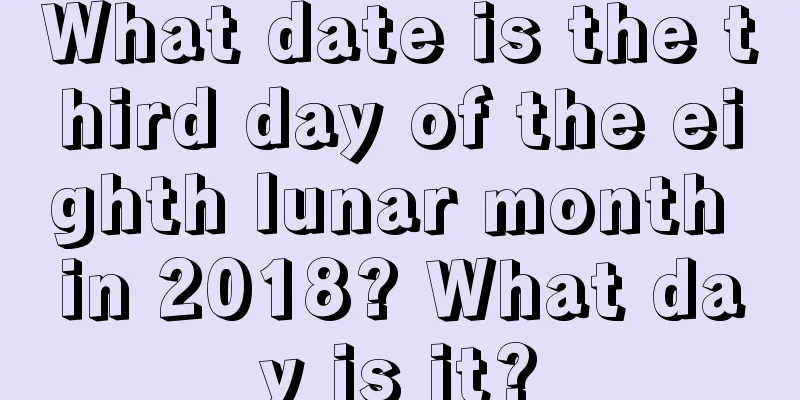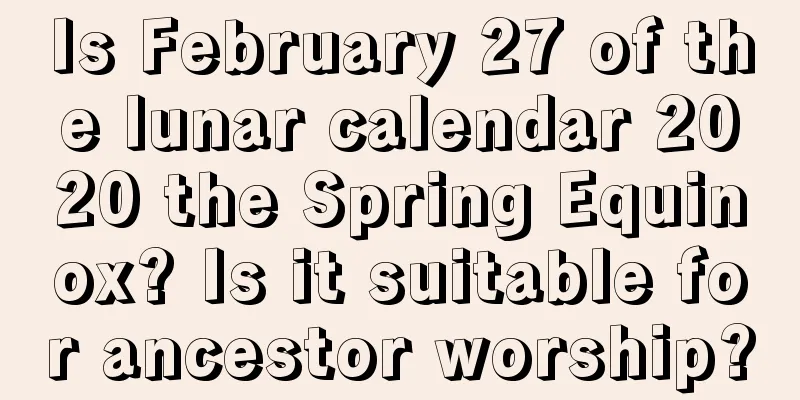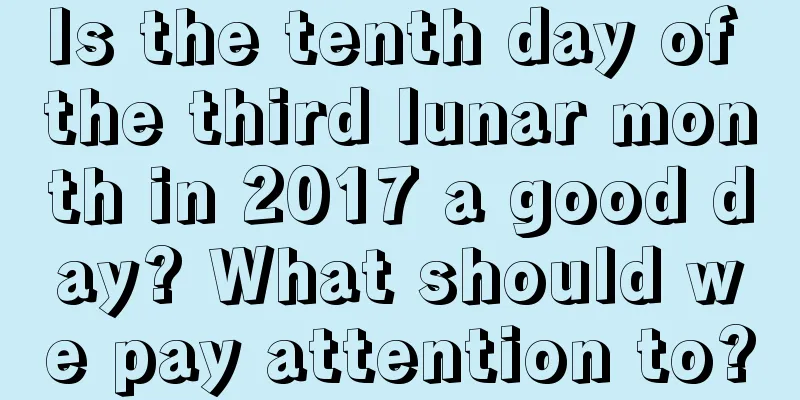Are there any customs for the Spring Equinox? When is the Spring Equinox in 2018?

Introduction: The Spring Equinox is one of the 24 solar terms in our country, and there are many customs related to the Spring Equinox. So are there any customs for the Spring Equinox? When is the Spring Equinox in 2018? Follow the editor to learn more about it! Winter has gone and spring has come. February in the lunar calendar has already entered spring. The Fortune Teller website provides you with more detailed information about February in the lunar calendar of 2018!Are there any customs during the Spring Equinox?1. Beginning of Spring Egg <br /> It is said that on the day of the Spring Equinox every year, tens of millions of people around the world will do the "standing egg" experiment. As early as 4,000 years ago, China had the tradition of standing eggs on the Spring Equinox to celebrate the arrival of spring. Later it gradually evolved into a tradition of praying for good luck.If you want to successfully "stand an egg upright", you can choose a smooth and symmetrical fresh egg that has been laid for only four or five days, and try to stand it upright on a flat table. Although there are many failures, there are also many successes. Some people explain that this is because the earth's axis is tilted at 66.5 degrees on the "vernal equinox", which is in a state of relative force balance with the orbital plane of the earth's revolution around the sun, which is very conducive to "standing the egg". It is said that a standing egg can remain standing for more than ten days without any external interference. 2. Eating spring vegetables <br /> In some areas of Lingnan, there is a non-festival custom on the Spring Equinox, called "eating spring vegetables on the Spring Equinox." "Spring vegetable" is a kind of wild amaranth, which the locals call "Spring Green Artemisia". On the day of the Spring Equinox, people go to pick spring vegetables. When searching in the fields, most of the plants you see are light green, thin, about the length of a palm. The harvested spring vegetables are usually boiled with fish fillets in a soup called "spring soup". There is also a folk rhyme to record this: "Spring soup nourishes the internal organs, cleanses the liver and intestines; the whole family, young and old, is safe and healthy." The plan for the year lies in spring, when the vernal equinox arrives. Faced with the sprouting of all things, people naturally pray for peace in their homes and good health. 3. Spring Festival <br /> On the Spring Equinox in February, tomb sweeping and ancestor worship begins, also known as the Spring Festival. Before folks visit the graves, they first hold a grand ceremony to worship their ancestors in the ancestral hall, slaughtering pigs and sheep, inviting drummers to play music, having ritual students recite sacrificial texts, and leading the three offerings ceremony. When tomb sweeping begins on the Spring Equinox, the first things people do are to sweep and offer sacrifices to the tombs of the founding ancestors and distant ancestors. The entire clan and the entire village are mobilized, and the procession is large, with often hundreds or even thousands of people. After sweeping the tombs of the founding ancestor and distant ancestors, each room will then sweep and offer sacrifices to the tombs of their ancestors, and finally each family will sweep and offer sacrifices to the family's private tomb. In most Hakka areas, spring ancestor worship and tomb sweeping begin at the Spring Equinox or earlier and are completed by Qingming Festival at the latest. There is a saying in various places that the tomb doors will be closed after Qingming Festival and the heroic spirits of the ancestors will no longer be able to benefit from it. 4. Catch the sparrow's mouth <br /> On the day of the Spring Equinox, farmers have a holiday according to custom. Every family eats glutinous rice dumplings, and they also cook more than ten or twenty to thirty glutinous rice dumplings without fillings, stick them with thin bamboo forks and place them on the edge of the field outside. This is called "catch the sparrow's mouth" to prevent sparrows from destroying the crops. The spring equinox is also a great time for kids to fly kites. Especially on the day of the Spring Equinox. Even the adults get involved. There are many types of kites, including the Wang-shaped kite, the silver carp kite, the squinting moth kite, the thunder worm kite, and the moonlight kite. The biggest ones are two meters high, and the smallest ones are two or three feet high. There are kites for sale in the market, most of which are relatively small and suitable for children to play with, but most are made by themselves and are larger. When flying them, people compete with each other to see who can fly the highest. 5. Memorial Day <br /> During the Zhou Dynasty, there was a memorial day ceremony on the Spring Equinox. Pan Rongbi of the Qing Dynasty wrote in "Annals of the Capital's Customs": "On the Spring Equinox, the emperor worships the sun, and on the Autumnal Equinox, the emperor worships the moon. These are grand ceremonies of the country, and the scholars and common people are not allowed to offer sacrifices at their own will." The places for emperors to worship the sun were mostly located in the suburbs of Beijing. During the Yuan Dynasty, the Sun Altar was built. After that, the emperors of the Ming and Qing dynasties offered sacrifices to the Great Ming God (the Sun) at the Sun Altar on the day of the Spring Equinox. The morning sun was set at the hour of Mao on the Spring Equinox. In the years of Jia, Bing, Wu, Geng and Ren, the emperor would personally offer sacrifices, while in other years, officials would offer sacrifices on his behalf. The current Temple of the Sun in Beijing was built in the ninth year of the Jiajing reign of the Ming Dynasty (1530). It is the place where the emperors of the Ming and Qing dynasties worshipped the Sun God (known in ancient times as the "God of the Great Ming"). Over a period of more than 400 years starting from the first year of the Longqing reign of the Ming Dynasty (1567), five emperors, namely Tianqi, Chongzhen, Qianlong, Jiaqing and Daoguang, came to the Sun Altar to worship in person. After the 23rd year of Emperor Daoguang’s reign in the Qing Dynasty (1843), the “Day of Sacrifice” activities gradually disappeared and have been interrupted for more than 160 years. When is the Spring Equinox in 2018?Wednesday, March 21, 2018 (the fifth day of the second month of the Wuxu Year (Year of the Dog), 9 days until the Spring Equinox of 2018)The Spring Equinox is the midpoint of the ninety days of spring. One of the 24 solar terms, it falls on March 20 of the Gregorian calendar every year when the sun is at 0° of ecliptic longitude (the vernal equinox). On the day of the vernal equinox, the sun shines directly on the earth's equator. The seasons in the northern and southern hemispheres are opposite. In the northern hemisphere, it is the vernal equinox, and in the southern hemisphere, it is the autumnal equinox. The Spring Equinox is the New Year in Iran, Türkiye, Afghanistan, Uzbekistan and other countries, and has a history of 3,000 years. Summary: The above content is about [Are there any customs for the Spring Equinox? When is the Spring Equinox in 2018? 】Problem analysis, hope it can help everyone! |
<<: What are the customs of Dragon Raising its Head on February 2, 2018?
>>: The meaning of the Dragon Raising its Head on February 2
Recommend
Is the 11th day of the fifth lunar month in 2017 a suitable day for marriage? Will you be happy?
Introduction: Marriage is one of the most importan...
What about a girl born on July 25th of the lunar calendar in 2020? Is the girl's fate good?
A lot of people are born every day. Different peop...
Is it a good time to pick up your car on the fifth day of the third lunar month in 2020? Check the auspicious day to pick up your car!
Choosing an auspicious day to pick up the car can...
What is the zodiac sign of a baby born on October 29, 2018 in the lunar calendar?
The tenth month of the lunar calendar is also know...
Are there any good days in the third lunar month of 2022? Which day is good?
The days in each month are different. Sometimes th...
Is it true that people born on the Cold Dew Day have a hard life? Is the Cold Dew Day in 2020 an auspicious day?
Introduction: People born on different days have d...
Is it a good time to travel on May 28th of the lunar calendar in 2022? Can I travel far away?
Is it a good time to travel on May 28th of the lun...
What gifts can I prepare for my mother on Mother's Day? Can't I open on Mother's Day in 2020?
Introduction: Giving mothers gifts on Mother's...
Can I get married on November 21st of the lunar calendar in 2020?
The eleventh month of the lunar calendar heralds t...
Is the seventh day of the tenth lunar month in 2018 an auspicious day? Is the hexagram a good omen?
Introduction: According to the tradition of our co...
Can we offer sacrifices to our ancestors on the fifth day of the tenth lunar month in the Gengzi Year of 2020?
Can we offer sacrifices to our ancestors on the fi...
Is the third day of the third lunar month in 2018 an auspicious day for “offering sacrifices to Xuanyuan”?
There is a Chinese saying that goes, "On the ...
Is it okay to renovate on the 30th day of the first lunar month in 2022? Feng Shui considerations for decoration
There are certain considerations when choosing the...
Is the 13th day of the seventh lunar month in 2019 a suitable day for repairing graves? What should we pay attention to when repairing graves?
Introduction: Repairing graves is also an importan...
Is the Cold Clothes Festival on the first day of the tenth lunar month in 2019 an auspicious day? Do we visit the graves on the Cold Clothes Festival?
Introduction: Every day has its good and bad luck....









